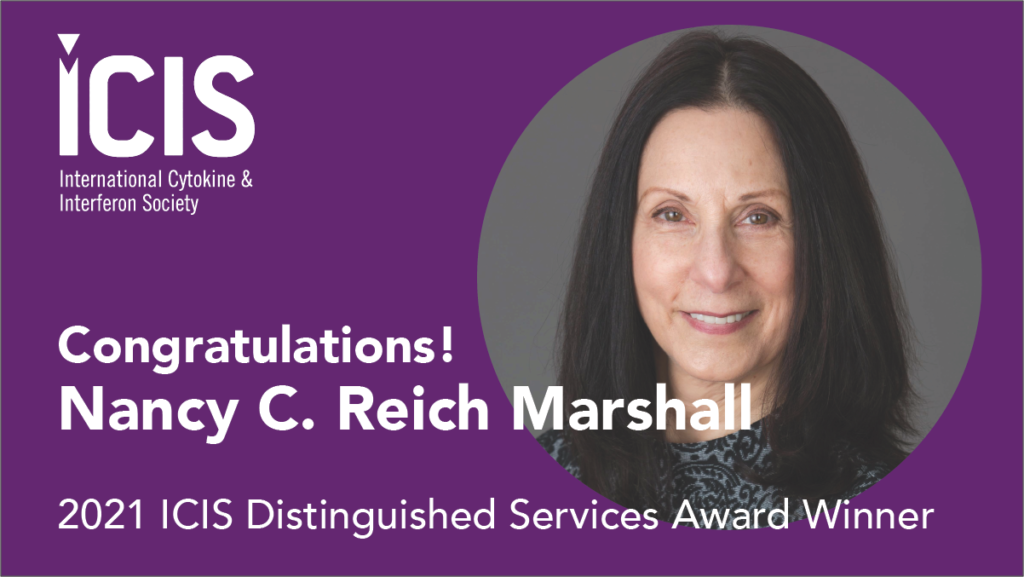Nancy C. Reich Marshall, PhD
Professor, Microbiology & Immunology
Stony Brook University
Stony Brook, USA
Fellow of The American Association for the Advancement of Science (AAAS)
Fellow of The American Academy of Microbiology (AAM)
Dr. Nancy Reich is honored with the ICIS Distinguished Service award in recognition of her extraordinary contributions to the cytokine research community. She has been active as a member in the ISICR and ICIS since 1987. Dr. Reich served as a member of the Meetings Committee, Awards Committee, Nominating Committee, International Council, and co-Chaired the Society annual conference in Puerto Rico 2004. Following her election as ICIS President-Elect in 2015, she Chaired a Reorganizing Committee and was responsible for streamlining the management of the organization to better serve the needs of the community. Subsequently as ICIS President, she implemented policies to further enhance the standing of the ICIS internationally, and also to ensure that members engaged in the ICIS. Dr. Reich is respected for her perspective, thoughtful input, and service. Dr. Reich has been and continues to be an invaluable member of the ICIS, engaging in Society activities and contributing in many different areas of decision making. Her research accomplishments were recognized by the Society as a 2005 recipient of the Vivian and Seymour Milstein Award for Outstanding Interferon and Cytokine Research. Dr. Reich is also a dedicated science educator and has personally guided the research training of 20 Ph.D. candidates, seeding the community with highly trained scientists.
Dr. Reich received her Ph.D. from the State University of New York in 1984 for research with the p53 tumor suppressor in the laboratory of Dr. Arnold J. Levine. She pursued postdoctoral training on interferon signaling at The Rockefeller University with Dr. James E. Darnell Jr., and continued studies on the response of cells and organisms to cytokines and interferons at Stony Brook University where she is currently Professor of Microbiology and Immunology. Her studies converged on the activation of two transcription factor families, the interferon regulatory factors (IRFs) and the signal transducers and activators of transcription (STATs). She discovered a novel cellular DNA-binding factor activated in response to dsRNA and capable of inducing interferon-stimulated genes in the absence of interferon (Daly et al. MCB, 1993). This factor was later identified as IRF-3 and plays an essential role in the early responses of cells to viral invasion (Weaver et al. MCB, 1998; Kumar et al. MCB, 2000). During this time Dr. Reich reported the requirement for tyrosine phosphorylation in the activation of interferon stimulated transcription factors later designated STAT1 and STAT2 (Gutch et al. PNAS, 1992), interleukin-4 stimulated STAT6 (Kotanides et al. Science, 1993) and interleukin-5 stimulated STAT5 (Gilmour et al PNAS, 1995). She elucidated mechanisms that regulate STAT1 nuclear trafficking dependent on conformational changes that occur subsequent to tyrosine phosphorylation, and both import and export signals were found to have co-evolved with the DNA binding domain (McBride et al. EMBO J, 2000, 2002). Her work later showed that STAT1 nuclear trafficking was distinct from other STATs. STAT3, STAT5 and STAT6 were shown to traffic in and out of the nucleus continually without phosphorylation (Liu et al. PNAS, 2005). These findings are important to conceptual approaches to enable or disable STAT transcription factors in cancer or infectious disease.
More recently Dr. Reich has contributed to our understanding of the pathology of infections and cancer using murine model systems. STAT3 was shown to be critical in promoting chronic infection and establishment of B cell latency in a model of gammaherpesvirus (Reddy et al. mBio, 2016). Viral latency is a critical medical challenge, and these results provide a potential therapeutic cellular target as well as an understanding of the molecular basis of viral latency. She also defined a fundamental and previously unrecognized function of STAT3 in the maintenance of epithelial cell identity and differentiation in cancer. Loss of STAT3 preferentially associated with the acquisition of mesenchymal-like phenotypes and more aggressive tumor behavior in mutant KRAS-initiated pancreatic cancer (D’Amico et al., G&D 2018). Immune evasion is a hallmark of KRAS-driven cancers, but the underlying causes remain unresolved. Dr. Reich’s team used a murine model of pancreatic ductal adenocarcinoma to inactivate mutant KRAS by CRISPR-mediated genome editing and demonstrated that at an advanced tumor stage, dependence on KRAS for tumor growth is reduced and is manifested in the suppression of antitumor immunity (Ischenko et al. Nat Comm 2021). With the development of KRAS inhibitors, the data imply that treatment with inhibitors will require concurrent activation of immune pathways suppressed by the cancer.

